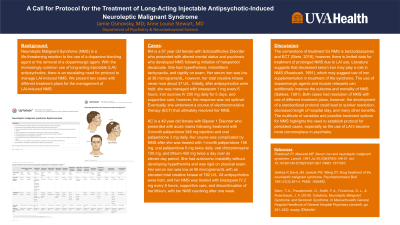Catatonia
(012) A Call for Protocol for the Treatment of Long-Acting-Injectable Antipsychotic-Induced Neuroleptic Malignant Syndrome

- JO
Jamie Osinovsky, MD
Assistant Professor
University of Virginia
Charlottesville, Virginia - AS
Anne Louise Stewart, MD
Assistant Professor
Univeristy of Virginia
Charlottesville, Virginia
Presenting Author(s)
Co-Author(s)
Background:
Neuroleptic Malignant Syndrome (NMS) is a life-threatening reaction to the use of a dopamine-blocking agent or the removal of a dopaminergic agent. With the increasingly common use of long-acting injectable (LAI) antipsychotics, there is an escalating need for protocol to manage LAI-induced NMS. We present two cases with different treatment plans for the management of LAI-induced NMS. Case: RH is a 57 year old female with Schizoaffective Disorder who presented with altered mental status and psychosis who developed NMS following initiation of haloperidol decanoate. She had hyperthermia, intermittent tachycardia, and rigidity on exam. Her serum iron was low at 38 micrograms/dL, however, her total creatine kinase never rose about 37 U/L. Initially, after antipsychotics were held, she was managed with lorazepam 1 mg every 6 hours, iron sucrose IV 200 mg daily for 5 days, and supportive care, however, the response was not optimal. Eventually, she underwent a course of electroconvulsive therapy (ECT) that ultimately resolved her NMS. KC is a 49 year old female with Bipolar 1 Disorder who presented with acute mania following treatment with 3-month paliperidone 546 mg injection and oral paliperidone 3 mg daily. Her course was complicated by NMS after she was treated with 1-month paliperidone 156 mg, oral paliperidone 6 mg twice daily, oral chlorpromazine 100 mg, and lithium 450 mg twice a day over an eleven-day period. She had autonomic instability without developing hyperthermia and was rigid on physical exam. Her serum iron was low at 46 micrograms/dL with an elevated total creatine kinase of 782 U/L. All antipsychotics were held, and her NMS was treated with lorazepam IV 2 mg every 6 hours, supportive care, and discontinuation of her lithium, with her NMS resolving after one week. Discussion: The cornerstone of treatment for NMS is benzodiazepines and ECT (Stern, 2018), however, there is limited data for treatment of prolonged NMS due to LAI use. Literature suggests that decreased serum iron may play a role in NMS (Rosebush, 1991), which may suggest use of iron supplementation in treatment of the syndrome. The use of dopaminergic agents and muscle relaxants can additionally improve the outcome and mortality of NMS (Sakkas, 1991). Both cases had resolution of NMS with use of different treatment plans, however, the development of a standardized protocol could lead to quicker resolution, decreased length of hospital stay, and many other benefits. The multitude of variables and possible treatment options for NMS highlights the need to establish protocol for persistent cases, especially as the use of LAI’s become more commonplace in psychiatry. References: Rosebush PI, Mazurek MF. Serum iron and neuroleptic malignant syndrome. Lancet. 1991 Jul 20;338(8760):149-51. doi: 10.1016/0140-6736(91)90138-f. PMID: 1677067. Sakkas P, Davis JM, Janicak PG, Wang ZY. Drug treatment of the neuroleptic malignant syndrome. Psychopharmacol Bull. 1991;27(3):381-4. PMID: 1685592. Stern, T. A., Freudenreich, O., Smith, F. A., Fricchione, G. L., & Rosenbaum, J. F. (2018). Catatonia, Neuroleptic Malignant Syndrome, and Serotonin Syndrome. In Massachusetts General Hospital Handbook of General Hospital Psychiatry (seventh, pp. 261–263). essay, Elsevier.
Presentation Eligibility: Not previously published or presented.
Diversity, Equity, and Inclusion: Both patients presented in these cases are African American. Given that catatonia/NMS may be unproportionally seen in this population, with higher doses of antipsychotics found to be used in African American males, they may benefit most from determining a protocol for treatment of LAI-induced NMS.

